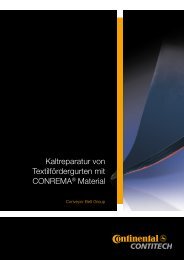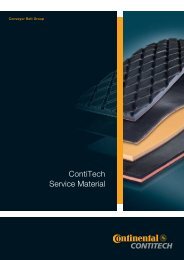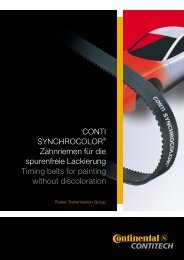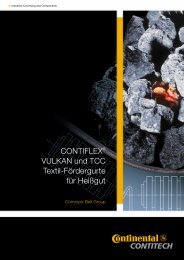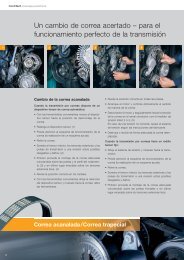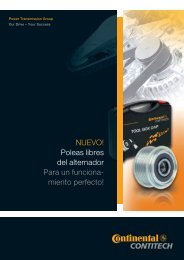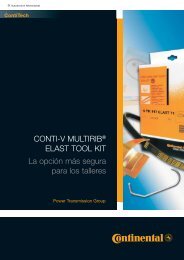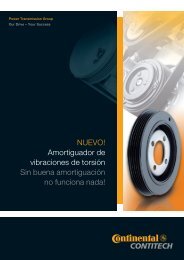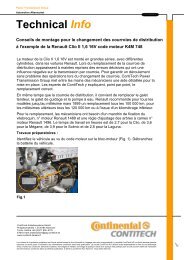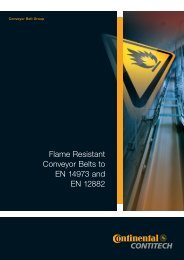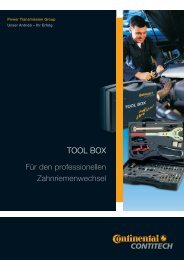Timing belts - ContiTech AG
Timing belts - ContiTech AG
Timing belts - ContiTech AG
Create successful ePaper yourself
Turn your PDF publications into a flip-book with our unique Google optimized e-Paper software.
Power Transmission Group<br />
Our Drive – Your Success<br />
Practical Tips<br />
Original quality –<br />
the best replacement
<strong>ContiTech</strong> Practical Tips<br />
www.contitech.de/aam<br />
Register for our Technical<br />
News and Technical Info.
CONTI ®<br />
multiple V-ribbed <strong>belts</strong>, V-<strong>belts</strong><br />
and timing <strong>belts</strong> in day-to-day use<br />
Part of your job is to check the power transmission <strong>belts</strong><br />
of your customers’ vehicles – for safety’s sake. When<br />
it’s a matter of driving accessories, opt for original quality<br />
from <strong>ContiTech</strong>: CONTI-V MULTIRIB ® V-ribbed <strong>belts</strong><br />
and CONTI ® -SF V-<strong>belts</strong> or a CONTI-V MULTIRIB ® KIT<br />
with multiple V-ribbed <strong>belts</strong>, tensioning pulleys and/or<br />
idlers in one pack. Opt for CONTI SYNCHROBELT ®<br />
timing <strong>belts</strong> or a CONTI SYNCHROBELT ® KIT with<br />
timing <strong>belts</strong>, idlers, tensioning pulleys and/or guide<br />
pulleys in one set. They help avoid the worst case<br />
situation of expensive engine failure. Opt for the quality<br />
that leading vehicle manufacturers prefer as original<br />
equipment.<br />
Our environmental management system is certified to<br />
DIN EN ISO 14001 and provides for reduced waste and<br />
solvents in production and for careful handling of raw<br />
materials. This brochure gives you some practical tips<br />
on how to handle and install <strong>belts</strong> so that they run<br />
smoothly and have a long service life.<br />
The <strong>ContiTech</strong> Power Transmission Group develops and<br />
supplies a wide range of quality products for all prominent<br />
vehicle manufacturers – from individual drive <strong>belts</strong><br />
to complete power transmission systems. In the drive<br />
for success. This is not only our motto but also a very<br />
promising prospect for our customers. The assistance<br />
we provide for the independent repair trade is backed<br />
by our participation in support services such as TecDoc,<br />
TecCom, Partslife and Mr. ATZ.<br />
P. 4-9 Multiple V-ribbed <strong>belts</strong>,<br />
V-<strong>belts</strong> and kits<br />
P. 4-5 Product<br />
P. 6-7 Changing the belt<br />
P. 8 Checklist<br />
P. 9 Troubleshooting<br />
P. 10-15 <strong>Timing</strong> <strong>belts</strong><br />
and kits<br />
P. 10 -11 Product<br />
P. 12-13 Changing the belt<br />
P. 13 Profiles of timing <strong>belts</strong><br />
and timing belt pulleys<br />
P. 14 Checklist<br />
P. 15 Troubleshooting<br />
P. 16-17 Wall display racks<br />
and sales stands<br />
P. 17 Storage<br />
P. 18 Gauges<br />
P. 19 Equipment
4<br />
<strong>ContiTech</strong> Practical Tips<br />
Original equipment quality products –<br />
safe, reliable and efficient<br />
CONTI-V MULTIRIB ® multiple V-ribbed <strong>belts</strong><br />
The CONTI-V MULTIRIB ® multiple V-ribbed belt for standard<br />
1) and serpentine 2) drives in cars and commercial<br />
vehicles is extremely safe, reliable and efficient. When<br />
fitted in serpentine drives with automatic tensioning, this<br />
belt does not need to be retightened.<br />
Size designation (example)<br />
6 PK 1980<br />
6 number of ribs<br />
PK profile designation/<br />
spacing of ribs 3.56 mm<br />
1980 effective length (mm)<br />
Synthetic rubber<br />
backing<br />
Polyester tension<br />
members<br />
Fibrous polychloroprene<br />
base compound<br />
1) 2 to 3 pulley drives with a fixed tensioning pulley<br />
2) assemblies lying in one plane and driven by one belt<br />
Tensioning pulleys, idler pulleys<br />
When opting for multiple V-ribbed <strong>belts</strong> made by<br />
<strong>ContiTech</strong>, you are choosing a superior product in<br />
original equipment quality. To ensure the quality of our<br />
products and kits, we only use tensioning pulleys and<br />
idlers made by leading suppliers of original equipment.<br />
These matching components of a belt drive system<br />
ensure that the multiple V-ribbed belt provides the<br />
correct tension, guidance and power transmission.<br />
CONTI ® -SF V-<strong>belts</strong><br />
The CONTI ® -SF V-belt for standard drives 1) in passenger<br />
cars and commercial vehicles is maintenance-free, safe,<br />
reliable and efficient. This belt does not need to be retensioned<br />
once fitted properly.<br />
Size designation (example)<br />
AVX 10 x 950<br />
AVX profile<br />
10 belt width (mm)<br />
950 total length (mm)<br />
Generator<br />
Configuration of a<br />
multiple V-ribbed belt<br />
Multiple V-ribbed and V-<strong>belts</strong>/Kits<br />
Water pump<br />
Cover fabric<br />
Polyester tension members<br />
Tension member cushioning<br />
Fibrous polychloroprene<br />
base compound<br />
Crankshaft<br />
Power steering<br />
Tensioning pulley
CONTI-V MULTIRIB ® KIT<br />
Depending on the application, this product combines<br />
multiple V-ribbed <strong>belts</strong>, tensioning pulleys and/or idlers<br />
in a single pack. Replacing the matching parts at the<br />
same time the multiple V-ribbed belt is changed gives<br />
extra engine reliability and means greater safety for the<br />
motorist. There are also benefits for the garage: no need<br />
to order individual parts, all items are perfectly matched,<br />
and there is sturdy packaging to protect the products<br />
before they are used.<br />
Kit with<br />
idler<br />
q All multiple V-ribbed <strong>belts</strong> and V-<strong>belts</strong><br />
are shown in the comprehensive <strong>ContiTech</strong><br />
application guides and match up lists for<br />
passenger cars and commercial vehicles<br />
as well as on TecDoc, the electronic data<br />
catalogue (CD ROM).<br />
Kit with torsional<br />
vibration damper<br />
Elast tool kit<br />
5
1<br />
6<br />
<strong>ContiTech</strong> Practical Tips<br />
Changing the belt correctly –<br />
for 100 % drive performance<br />
2<br />
Changing a multiple V-ribbed belt<br />
If the belt drive has an automatic tensioning system:<br />
• Use appropriate tools to move the tensioner to belt<br />
removal position.<br />
• Secure the tensioner in this position. (1)<br />
• Make sure you are familiar with the belt configuration<br />
(drawing a sketch helps).<br />
• Remove the belt.<br />
• Check tensioner, back idler pulleys and belt pulleys for<br />
any wear or damage. (2)<br />
• Ensure you have the correct belt size. First place it<br />
over the plain and flanged pulleys (3), and then push it<br />
over the smooth back idler pulleys. (4)<br />
• Check that the belt is properly seated in the grooves.<br />
• Release the tensioner securing mechanism with a<br />
suitable tool and move the tensioner against the belt.<br />
Remove all tools.<br />
• Check that the belt is properly seated on all pulleys.<br />
• Start the engine and watch that the belt is running<br />
along its intended path.<br />
3 4<br />
• Turn off the engine. Use the Krikit 2 or Krikit 3 tension<br />
gauge to check the belt tension on the taut section of<br />
the belt (5). If the tension is incorrect, check the<br />
tensioning system against the manufacturer’s data.<br />
• Dispose of the replaced belt in an environmentally<br />
friendly way.<br />
If the belt drive includes a fixed tensioning pulley:<br />
• Release the tensioning system and move it into the<br />
drive unit.<br />
• Make sure you are familiar with the belt configuration<br />
(drawing a sketch helps).<br />
• Remove the belt.<br />
Multiple V-ribbed <strong>belts</strong> and V-<strong>belts</strong><br />
• Check tensioner, back idler pulleys and belt pulleys<br />
for any wear or damage.<br />
• Ensure you have the correct belt size. First place it<br />
over the plain and flanged pulleys, and then push it<br />
over the smooth back idler pulleys.<br />
• Check that the belt is properly seated in the grooves.
5 6<br />
• Use the Krikit 2 or Krikit 3 tension gauge to check<br />
the belt tension on the taut section of the belt. (5)<br />
New multiple V-ribbed <strong>belts</strong><br />
Profile PK: 12 -14 kg/rib<br />
Used multiple V-ribbed <strong>belts</strong><br />
Profile PK: 9-10 kg/rib<br />
• Let the engine run for a few minutes, then switch it<br />
off. Check the tension and make any necessary<br />
adjustments.<br />
• Dispose of the replaced belt in an environmentally<br />
friendly way.<br />
Changing a V-belt<br />
Changing V-<strong>belts</strong> is similar to changing multiple Vribbed<br />
<strong>belts</strong> with a fixed tensioning pulley. Use the<br />
Krikit 1 tension gauge to adjust the belt tension (6).<br />
New V-<strong>belts</strong><br />
Profile AVX 10: 40 kg<br />
Profile AVX 13: 55 kg<br />
Used V-<strong>belts</strong><br />
Profile AVX 10: 25-30 kg<br />
Profile AVX 13: 40-45 kg<br />
CONTI ® BTT Hz (Belt Tension Tester):<br />
Electronic alternative for measuring<br />
the tension of multiple V-ribbed <strong>belts</strong><br />
Safety tips<br />
• When installing <strong>belts</strong>, only use the correct tool (not<br />
a screwdriver). The belt must be installed without the<br />
use of force.<br />
• Belt dressing or similar materials should be used only<br />
in emergencies to eliminate noises.<br />
• Never allow caustic or corrosive liquids to come into<br />
contact with the belt drive, as they could damage<br />
the plastic parts.<br />
• Check that the belt pulleys are in flawless condition<br />
(no dirt, rust or burrs) and are the correct size for the<br />
belt profile.<br />
• Ensure that the pulleys are properly aligned parallel<br />
to the axis.<br />
• V-belt drives in sets contain <strong>belts</strong> in matched lengths.<br />
If any one belt fails, all <strong>belts</strong> must be replaced.<br />
7
8<br />
<strong>ContiTech</strong> Practical Tips<br />
Problem – diagnosis – solution:<br />
Building on experience<br />
Checklist for multiple<br />
V-ribbed <strong>belts</strong><br />
Tension • Tensioning system?<br />
Damage to the • Back idler pulleys/<br />
back of the belt Back idler roller<br />
bearings?<br />
• Foreign matter?<br />
Unacceptable wear • Foreign matter?<br />
on belt ribs – • Mounting of pulleys?<br />
cracks/separations • Pulley alignment?<br />
• Ageing?<br />
Dirt accumulation • Leaks in the<br />
engine or engine<br />
compartment?<br />
Drive noises • Tension?<br />
• Pulley alignment?<br />
• Dirt accumulation?<br />
Checklist for V-<strong>belts</strong><br />
Tension • Tension system?<br />
Wear on flanks • Pulley alignment?<br />
Mounting of pulleys?<br />
Cracks/separations • Foreign matter?<br />
• Ageing?<br />
Dirt accumulation • Leaks in the<br />
engine or engine<br />
compartment?<br />
Drive noises • Tension?<br />
• Pulley alignment?<br />
• Dirt accumulation?<br />
Also available as poster<br />
Multiple V-ribbed <strong>belts</strong> and V-<strong>belts</strong>
Problem and cause Multiple V-ribbed <strong>belts</strong>/V-<strong>belts</strong> Solution<br />
Hardened, polished flanks<br />
� Incorrect tensioning<br />
� Tension member of belt damaged<br />
by incorrect fitting<br />
Uneven wear on ribs<br />
� Pulleys are not aligned<br />
� Substantial belt vibrations<br />
Running noises from belt<br />
� Insufficient tension<br />
� Belt past its useful life<br />
Cracks/separations in belt body/ribs<br />
� Belt tension is too high/low<br />
� Belt past its useful life<br />
� Foreign matter<br />
Crack in the belt after a short running time<br />
� Tension members damaged as<br />
a result of incorrect fitting<br />
� Belt excessively tensioned<br />
Dirt accumulation on the belt<br />
� Leaks in the engine or engine compartment<br />
(e.g. escape of oil, antifreeze etc.)<br />
Problem and cause Multiple V-ribbed <strong>belts</strong> Solution<br />
Damage to the back of the belt<br />
� Back idler pulley defective (sluggish, surface damaged,<br />
e.g. by foreign matter)<br />
Unacceptable wear of belt ribs<br />
� Pulleys/idlers/assemblies defective (sluggish)<br />
� Pulleys not aligned<br />
Problem and cause V-<strong>belts</strong> Solution<br />
Hardened, polished flanks (different<br />
tension values for <strong>belts</strong> of sets)<br />
� Pulleys not aligned<br />
� Tension member of belt damaged<br />
by incorrect fitting<br />
� Mismatching of <strong>belts</strong><br />
Excessive wear on flanks/flanks brittle<br />
� Excessive slip<br />
� Pulleys not aligned<br />
� Pulley grooves with uneven wear<br />
� Change the belt, adjust tension correctly<br />
� Change the belt, fit properly<br />
� Examine the drive. Line up or, if necessary,<br />
replace any non-aligned pulleys, change the belt<br />
� Check the tension. If necessary, tighten or change the belt<br />
� Tighten or change the belt<br />
� Change the belt<br />
� Change the belt, adjust tension correctly<br />
�� Change the belt<br />
� Change the belt, fitting it correctly<br />
� Change the belt, adjust tension correctly<br />
� Repair leak(s), change the belt<br />
� Change the belt, replace the back idler pulleys<br />
� Replace pulleys/idlers/assemblies, change the belt<br />
� Align or replace pulleys, change the belt<br />
� Examine the drive, line up non-aligned pulleys<br />
and fit a new set of <strong>belts</strong><br />
� Change the belt, fitting it correctly<br />
� Always replace a complete set of <strong>belts</strong><br />
� Change the belt, adjust the tension correctly<br />
� Examine the drive, line up or, if necessary, replace<br />
any non-aligned pulleys<br />
� Line up or, if necessary, replace any non-aligned pulleys,<br />
change the belt<br />
9
10<br />
<strong>ContiTech</strong> Practical Tips<br />
Top-class products –<br />
safe to use, low noise, zero maintenance<br />
CONTI SYNCHROBELT ® timing <strong>belts</strong> in three different<br />
basic profiles (trapezoidal, HTD, STD) ensure synchronous<br />
power transmission. They are reliable, quiet and<br />
maintenance-free. They are used in passenger car<br />
engines to drive camshafts, fuel injection pumps and<br />
balancing shafts.<br />
CONTI SYNCHROBELT ® trapezoidal<br />
timing <strong>belts</strong><br />
Synthetic<br />
rubber backing<br />
Glass cord tension<br />
members<br />
with S/Z twists<br />
Polychloroprene teeth<br />
Polyamide fabric<br />
Profile t (mm) hs (mm) ht (mm)<br />
LA 9.525 4.1 1.9<br />
LAH 9.525 4.5 2.3<br />
t<br />
hs ht q The right timing <strong>belts</strong> and timing<br />
belt kits for all vehicles are listed<br />
in the comprehensive <strong>ContiTech</strong><br />
application guide for passenger<br />
cars and in TecDoc, the electronic<br />
data catalogue (CD ROM).<br />
<strong>Timing</strong> <strong>belts</strong>/Kits<br />
CONTI SYNCHROBELT ® HTD timing <strong>belts</strong><br />
Synthetic<br />
rubber backing<br />
Glass cord tension<br />
members<br />
with S/Z twists<br />
Polychloroprene teeth<br />
Polyamide fabric<br />
Profile t (mm) hs (mm) ht (mm)<br />
HTD 9.525 M 9.525 5.6 3.45<br />
t<br />
CONTI SYNCHROBELT ® STD timing <strong>belts</strong><br />
Synthetic<br />
rubber backing<br />
Glass cord tension<br />
members<br />
with S/Z twists<br />
Polychloroprene teeth<br />
Polyamide fabric<br />
Profile t (mm) hs (mm) ht (mm)<br />
STD 8 M 8.0 5.3 3.0<br />
t<br />
h t<br />
h s<br />
hs ht
Tensioning pulleys, idler/guide pulleys<br />
With timing <strong>belts</strong> from <strong>ContiTech</strong>, you are opting for a<br />
top product in original equipment quality. To ensure the<br />
quality of our products and kits we only use tensioning,<br />
idler and guide pulleys made by leading suppliers of<br />
original equipment. These matching components of a<br />
control drive ensure the correct tensioning, guiding and<br />
power transmitting of timing <strong>belts</strong>.<br />
Configuration of<br />
a timing belt drive<br />
Tensioning pulley<br />
Idler pulley<br />
Guide pulley<br />
Ball bearing<br />
Bearing ring<br />
Tensioning roller bearing<br />
!<br />
CONTI SYNCHROBELT ® KIT<br />
Be on the safe side<br />
Kit with<br />
water pump<br />
Depending on the application, this product combines<br />
timing <strong>belts</strong>, tensioning pulleys, idler and/or guide pulleys,<br />
and a water pump in a single pack. Replacing the timing<br />
belt and its matching parts at the same time gives extra<br />
engine reliability and means greater safety for the motorist.<br />
There are also benefits for the garage: no need to order<br />
individual parts, all items are perfectly matched, and<br />
there’s sturdy packaging to protect the products before<br />
they are used.<br />
In modern engines timing <strong>belts</strong> and matching components<br />
are subjected to a great deal of stress.<br />
High rotational speeds, vibrations and extreme temperatures<br />
can easily have a negative effect on the<br />
functioning of parts. Cracks below the metal surface,<br />
overheating and worn-out sealing rings of bearings<br />
lead to increased metal wear and even the jamming<br />
of pulleys. So they can easily cause belt damage.<br />
If a timing belt snaps when the engine is running,<br />
the engine can sustain irreparable damage. So it<br />
is strongly recommended that timing <strong>belts</strong> and matching<br />
components are replaced at the same time,<br />
just to be on the safe side.<br />
11
1<br />
12<br />
<strong>ContiTech</strong> Practical Tips<br />
Changing the belt correctly –<br />
for 100 % drive performance<br />
2<br />
Changing a timing belt<br />
• Disconnect the earth cable from the battery.<br />
• Remove all drive <strong>belts</strong>, pulleys or hoses that could<br />
get in the way when the timing belt cover is removed.<br />
• Remove the timing belt cover.<br />
• Turn the crankshaft in the running direction of the<br />
engine as far as top dead centre, and bring marking<br />
on the engine case into line with the marking on the<br />
crankshaft vibration damper and the camshaft. (1)<br />
• Loosen the adjusting screw of the tensioning pulley.<br />
• Pull the tensioning pulley away from the timing belt<br />
and screw the tensioning pulley tight again. (2)<br />
• Remove the timing belt.<br />
• Check tensioner, smooth back idler pulleys, belt<br />
pulleys for wear or damage. If necessary replace<br />
them. (3)<br />
• Adjust all markings until they are properly aligned.<br />
• Place the new timing belt on the pulleys.<br />
<strong>Timing</strong> <strong>belts</strong><br />
3 4<br />
• Loosen the adjusting screw of the tensioning pulley,<br />
allowing the pulley to move freely.<br />
• Move the tensioning pulley carefully into its final<br />
position (make proper allowance for the spring<br />
pressure). If the tensioning pulley is not automatic,<br />
tension the timing belt as specified by the vehicle<br />
manufacturer, using the tensioning device provided<br />
for this. (4)<br />
• Check the alignment of the markings.<br />
• Rotate the crankshaft by at least two complete revolutions<br />
in the running direction of the engine to ensure<br />
the timing belt is properly tensioned by the tensioning<br />
pulley.<br />
• Check the alignment of the markings once again.<br />
• Put the tensioning pulley in its intended position<br />
and tighten the screws with the specified torque<br />
setting. (5)<br />
• Refit the timing belt cover as well as all drive <strong>belts</strong>,<br />
pulleys and hoses that were removed.<br />
• Reconnect the earth cable to the battery.<br />
• Start the engine.<br />
• Make any adjustments that are necessary.<br />
• Dispose of the replaced belt in an environmentally<br />
friendly way.
5<br />
Safety tips<br />
• When fitting <strong>belts</strong>, only use the correct tool. The belt<br />
must be placed in position manually. In no circumstances<br />
may timing <strong>belts</strong> be forced, e.g. with rim<br />
levers, on to toothed pulleys or rolled over flanged pulleys.<br />
Such action would damage the tension member.<br />
• Never allow caustic or corrosive liquids to come into<br />
contact with the belt drive, as they could damage the<br />
plastic parts.<br />
• Keep the belt well away from oil mist, dripping oil and<br />
other chemicals!<br />
• Always comply with the installation instructions of the<br />
vehicle manufacturer! These are printed in the owner’s<br />
manual in the section explaining how to change a<br />
timing belt.<br />
• Fill in the sticker accompanying every new <strong>ContiTech</strong><br />
timing belt and stick it in the engine compartment<br />
where it can easily be seen.<br />
• Regardless of which components are defective –<br />
whether tensioning pulley, idler pulley or guide<br />
pulley – all these components must be replaced!<br />
Profiles of timing <strong>belts</strong> and<br />
timing belt pulleys<br />
Code<br />
LA<br />
LAR<br />
LAN<br />
LAH<br />
LAHR<br />
LAHN<br />
HTD<br />
9.525 M<br />
HTDN<br />
9.525 M<br />
HTDH<br />
9.525 M<br />
HTDA<br />
9.525 M<br />
HTDA<br />
8 M<br />
HTDK<br />
8 M<br />
STD<br />
8 M<br />
STDN<br />
8 M<br />
CHDN<br />
9.525 M<br />
CHD<br />
9.525 M<br />
CPPN<br />
9.525 M<br />
Belt<br />
profile<br />
Pulley<br />
profile<br />
Examples of<br />
application<br />
Audi, Citroën, Fiat, Ford,<br />
Mazda, Opel/Vauxhall,<br />
Peugeot, Renault, Volvo, VW<br />
Audi, Fiat, Ford, Lada, Lancia,<br />
Mitsubishi, Opel/Vauxhall,<br />
Rover, Vauxhall, VW<br />
Fiat, VW<br />
Audi, Fiat, Ford, Opel/<br />
Vauxhall, Peugeot, Porsche,<br />
Renault, Volvo, VW<br />
Audi, Bedford,<br />
Mitsubishi, VW<br />
Audi, VW<br />
BMW, Citroën, Honda, Mazda,<br />
Opel/Vauxhall, Porsche,<br />
Renault, Rover, Volvo, VW<br />
Ford, Lada, Volvo<br />
Opel/Vauxhall<br />
Daihatsu, Honda, Mazda,<br />
Mitsubishi, Renault,<br />
Rover, Suzuki, Volvo<br />
Daihatsu, Mazda, Nissan,<br />
Rover, Subaru, Suzuki<br />
Mazda, Toyota<br />
Audi, Ferrari, Fiat,<br />
Lancia, Land-Rover, VW<br />
Fiat, Lancia<br />
Ford, Fiat, Citroën,<br />
Peugeot, Rover<br />
Fiat, Renault<br />
Citroën, Honda, Landrover,<br />
Peugeot, Rover<br />
13
14<br />
<strong>ContiTech</strong> Practical Tips<br />
Problem – diagnosis – solution:<br />
Ensuring a smooth operation<br />
Checklist for timing <strong>belts</strong><br />
Changing interval<br />
Tension • Tensioning system?<br />
Damage to the • Idler pulleys?<br />
back of the belt • Tensioning pulleys?<br />
• Foreign matter?<br />
Unacceptable wear • Toothed pulleys?<br />
of tooth profile • Assemblies?<br />
• Pulley alignment?<br />
• Foreign matter?<br />
Cracks/separations • Toothed pulleys?<br />
• Assemblies?<br />
• Foreign matter?<br />
• Pulley alignment?<br />
Edge wear • Pulley alignment?<br />
• Flanged pulley?<br />
Dirt accumulation • Leaks in the<br />
system components<br />
of the engine?<br />
Drive noises • Tension?<br />
• Pulley alignment?<br />
• Assemblies?<br />
• Idler/tensioning<br />
pulleys?<br />
Also available as poster<br />
<strong>Timing</strong> <strong>belts</strong>
Problem and cause <strong>Timing</strong> <strong>belts</strong> Solution<br />
Running noises from belt<br />
� Tension too high: Belt whines, whistles<br />
� Tension too low: Belt knocks against covering<br />
Edge wear<br />
� Belt not parallel to axis: Belt runs against flanged pulley<br />
� Wheels axially off-centre: <strong>Timing</strong> belt cannot be properly aligned<br />
� Flanged pulley has flaws<br />
� Bearing play in components<br />
Fabric wear in the tooth root<br />
� Belt excessively tensioned<br />
� Belt is overheating<br />
� <strong>Timing</strong> belt pulley is worn out<br />
Unacceptable wear of tooth flanks/<br />
base separating and tooth shearing<br />
� Tension too high/too low<br />
� Trapped foreign matter<br />
� Jammed timing belt pulley or tensioning pulley<br />
Teeth and fabric separating from belt body<br />
� Leaks in the engine or engine compartment<br />
(e.g. escape of oil, antifreeze etc.)<br />
Running marks on teeth side<br />
� Foreign matter in timing belt drive<br />
� Flaws in teeth of timing belt pulley caused<br />
by foreign matter or tools during fitting<br />
� <strong>Timing</strong> belt damaged before/during fitting<br />
Cracks on back of timing belt<br />
� Ambient temperature too high/low<br />
� Contact with foreign media<br />
� Back idler pulley sluggish<br />
� Ageing<br />
<strong>Timing</strong> belt snaps<br />
� Foreign matter in the drive<br />
� Contact with foreign media<br />
� Excessive tensioning<br />
� Belt was kinked before/during fitting<br />
Defective system components<br />
� Bearing play<br />
� Damaged pulley side of belt<br />
� � Adjust tension properly<br />
� � Check drive, line up or, if necessary, replace any<br />
non-aligned pulleys, change the belt<br />
�� Replace idler/tensioning pulleys, change the belt<br />
� Change the belt, adjust tension correctly<br />
� Find out cause (e.g. check cold performance),<br />
take corrective action, change the belt<br />
� Replace timing belt pulley, change the belt<br />
� Change the belt, adjust tension properly<br />
� Remove foreign matter, check covering<br />
is seated properly, change the belt<br />
� Find out cause (e.g. defective bearing),<br />
take corrective action, change the belt<br />
� Repair leak(s), change the belt<br />
� Remove foreign matter, change the belt,<br />
check the cover is seated properly<br />
� Replace timing belt pulley, change the belt,<br />
ensuring it is properly fitted<br />
� Change the belt, ensuring it is properly fitted<br />
� Find out cause (e.g. check cold performance), take<br />
corrective action, change the belt<br />
� Change the belt, check the covering is seated properly<br />
� Replace pulley, change the belt<br />
� Change the belt<br />
� Remove foreign matter/media, change the belt<br />
� Change the belt, check the covering is seated properly<br />
� Change the belt, adjust tension properly<br />
� Change the belt and fit it correctly<br />
�� Replace the idler, tensioning and/or guide pulleys<br />
15
16<br />
<strong>ContiTech</strong> Practical Tips<br />
Sales aids –<br />
compact and easy to use<br />
We supply wall display racks and stand-alone units<br />
that are ideal for customer self-service. These units communicate<br />
product information through their promotional<br />
panels and provide compact, high-capacity display<br />
storage.<br />
Hook rack, type A<br />
Width 90 cm<br />
takes max.<br />
42 <strong>belts</strong><br />
Wall rack for V-<strong>belts</strong>, type B<br />
Width 60 cm<br />
supplied with<br />
27 hooks for<br />
max. 27 V-<strong>belts</strong><br />
Wall rack for V-<strong>belts</strong> and<br />
multiple V-ribbed <strong>belts</strong>, type C/E<br />
Width 60 cm<br />
supplied with<br />
15 hooks for<br />
max. 75 V-<strong>belts</strong><br />
or for<br />
max. 45 multiple<br />
V-ribbed <strong>belts</strong><br />
Wall rack for timing <strong>belts</strong> and kits<br />
Width 60 cm<br />
• supplied with<br />
18 boxes of<br />
timing <strong>belts</strong> or<br />
• 6 boxes of<br />
timing belt kits<br />
Ladder with base<br />
Width 60 cm<br />
Height 185 cm<br />
can display<br />
various wall racks
Example of a filled<br />
sales stand<br />
Width 60 cm, height approx. 185 cm<br />
Reliability – thanks<br />
to correct storage<br />
Belts should be stored out of direct sunlight, at a cool<br />
ambient temperature (15-25˚C), dry and not in a<br />
draught. Correct storage will ensure that they continue<br />
to be reliable products even after a long storage time<br />
(up to 5 years).<br />
Basics for V-<strong>belts</strong>/multiple V-ribbed <strong>belts</strong><br />
Avoid keeping <strong>belts</strong> near to any heat source.<br />
Ozone-producing equipment, such as arcing electric<br />
switchgear, should not be operated for long in areas<br />
where <strong>belts</strong> are stored. Highly flammable, aggressive<br />
materials, lubricants or acids must also be kept away<br />
from stored <strong>belts</strong>.<br />
Basics for timing <strong>belts</strong><br />
Until they are used, timing <strong>belts</strong> should be left in their<br />
original packaging and carefully stored to avoid damage.<br />
The <strong>belts</strong> must not be buckled, as this could harm the<br />
length stability of the glass cord tension members.<br />
Highly flammable, aggressive materials, lubricants or<br />
acids must also be kept away from stored <strong>belts</strong>.<br />
17
18<br />
<strong>ContiTech</strong> Practical Tips<br />
Tool Box<br />
Technical service –<br />
for perfect fitting<br />
Particular attention must be paid to drive components,<br />
the most important control elements in the engine compartment.<br />
With <strong>ContiTech</strong> you are on the safe side,<br />
because we offer both first-class products and a comprehensive<br />
service:<br />
• telephone hotline (+49) 511 938 - 5178<br />
• technical training<br />
• useful measuring equipment<br />
Tools<br />
For the professional replacement of<br />
V-ribbed <strong>belts</strong> and timing <strong>belts</strong><br />
• CONTI ® TOOL BOX<br />
• CONTI ® TOOL BOX ASIEN CARS<br />
• CONTI ® UNI-TOOL ELAST<br />
Asia Tool Box<br />
Measuring gauge for V-<strong>belts</strong><br />
and multiple V-ribbed <strong>belts</strong><br />
• easy to use<br />
• easy to read<br />
• no converting<br />
Tension gauges<br />
for drives without automatic<br />
tensioning<br />
KRIKIT 1<br />
for V-<strong>belts</strong><br />
KRIKIT 2<br />
for multiple V-ribbed<br />
<strong>belts</strong> up to 70 kg<br />
tension<br />
CONTI ® BTT Hz (Belt Tension Tester)<br />
for measuring the<br />
tension of timing<br />
<strong>belts</strong> and multiple<br />
V-ribbed <strong>belts</strong><br />
KRIKIT 3<br />
for multiple V-ribbed<br />
<strong>belts</strong> from 70 to<br />
150 kg tension<br />
Elast Tool
Professional support –<br />
with the right equipment<br />
The practical and time-tested application guides for cars<br />
and commercial vehicles show which drive components<br />
are right for which vehicle. <strong>ContiTech</strong> products are listed<br />
in the electronic car parts catalogue TecDoc. This<br />
catalogue matches the application guides and covers<br />
virtually all vehicles in European fleets. Well-designed<br />
brochures and flyers provide information about<br />
<strong>ContiTech</strong>’s extensive service, together with technical<br />
tips and performance details. Our illuminated signs are<br />
attention-grabbers to attract your customers. Other<br />
sales promotional material is also available. Please<br />
ask for details.<br />
Application guides Brochures for retail and workshop use<br />
Flyers for motorists<br />
The right time for<br />
changing timing <strong>belts</strong><br />
for passenger cars and<br />
commercial vehicles<br />
Illuminated sign for interior and exterior use<br />
One-sided illumination for wall<br />
fitting or double-sided illumination<br />
94 x 65 x14 cm ( w xhxd)<br />
e.g. leaflets<br />
Posters<br />
19
WT 6909 E 10.11 (Br) Printed with <strong>ContiTech</strong> offset printing blankets on bleached paper free of chlorine<br />
www.contitech.de/aam<br />
Power Transmission Group<br />
Market segment<br />
Automotive Aftermarket<br />
Contact<br />
<strong>ContiTech</strong> Antriebssysteme GmbH<br />
Postfach 445<br />
D-30004 Hannover<br />
Philipsbornstrasse 1<br />
D-30165 Hannover<br />
Phone +49 511 938-71<br />
Fax +49 511 938-5065<br />
aam@ptg.contitech.de<br />
Your local contact:<br />
www.contitech.de/contactlocator<br />
q<br />
<strong>ContiTech</strong> power transmission <strong>belts</strong><br />
and accessories are available at:<br />
Certified in accordance with<br />
The <strong>ContiTech</strong> division<br />
of the Continental Corporation<br />
is a development partner and<br />
original equipment supplier<br />
to numerous industries for<br />
high-quality functional parts,<br />
components and systems.<br />
With its know-how in rubber<br />
and plastics technology,<br />
<strong>ContiTech</strong> contributes significantly<br />
to industrial progress<br />
and mobility that is safe,<br />
comfortable and eco-friendly.<br />
The content of this publication is not legally binding and is provided as information only. The trademarks displayed in this publication are the property of Continental <strong>AG</strong><br />
and/or its affiliates. Copyright © 2011 <strong>ContiTech</strong> <strong>AG</strong>. All rights reserved. For complete information go to: www.contitech.de/discl_en


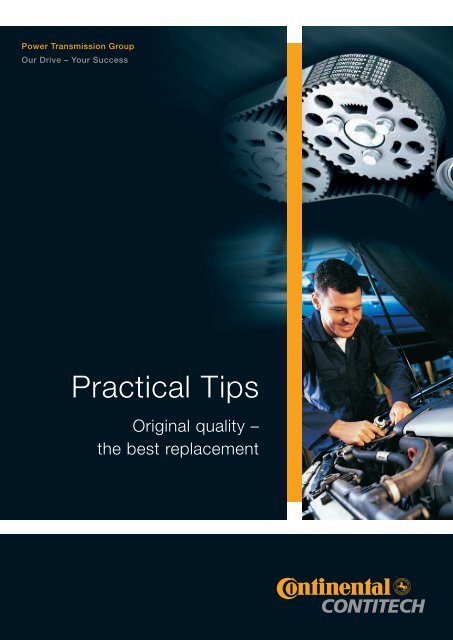
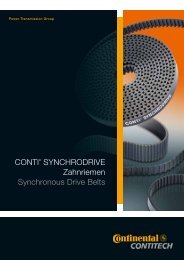
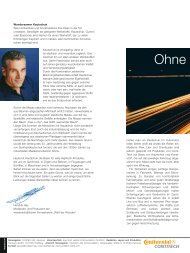
![Technical News 35/2011 [de, PDF, 256B]](https://img.yumpu.com/22013086/1/184x260/technical-news-35-2011-de-pdf-256b.jpg?quality=85)

